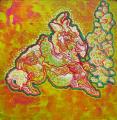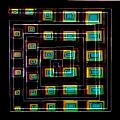
❤️🔥
 
Posts: 3648 Joined: 11-Mar-2017 Last visit: 02-Dec-2025 Location: 🌎
|
Large dataset for morning glories recently published 🙂 https://www.nature.com/articles/s42003-021-02870-z
|
|
|
|
|

DMT-Nexus member
Posts: 401 Joined: 31-May-2014 Last visit: 30-Dec-2023 Location: The confluence
|
Great find Loveall! Haven’t had a lot of luck with getting pods from the “heavenly blues” in my climate. Hopefully one of the others would be more adaptable or maybe even my local variety would be worth trying. "We dance round in a ring and suppose,
while the secret sits in the middle and knows." Robert Frost
|
|
|

DMT-Nexus member
Posts: 306 Joined: 04-Mar-2012 Last visit: 20-Jul-2025 Location: temperate dweller
|
Anybody else notice that this cites Ipomoea tricolor as having the most LSH (=LAH) of all species? Sitting at 150 ug/g total mixed LSH & LSA. Compared to Argyreia nervosa at 10 ug/g.
I haven't read the whole paper yet so I'm wondering why they found this. Usually A. nervosa is supposed to be more potent. Perhaps it was the wrong variety.
|
|
|

DMT-Nexus member
Posts: 1045 Joined: 12-Mar-2010 Last visit: 11-Jun-2024 Location: Urf
|
What are the qualitative differences between LSH and LSA? From the unspoken
Grows the once broken
|
|
|

DMT-Nexus member
Posts: 306 Joined: 04-Mar-2012 Last visit: 20-Jul-2025 Location: temperate dweller
|
It's hard to know, I don't think anyone has taken purified LSH because it's supposedly so unstable.
Chemically it looks more like LSD than LSA, I think it's more non-polar as well.
Albert Hoffman said his trials with pure LSA led to a sedated and not very psychologically engaging experience.
From my own experience taking hawaiian baby woodrose I found some were extremely psychically potent (the fresher looking, fuzzier ones) and others caused very little psychedelia with a lot of bodyload and sedation. My best experiences HBWR were more productive than LSD to me, but with a higher initial bodyload price tag. After a while the seed unpleasantness gave way to beautiful euphoria.
We also know that the Periglandula spp. in Ipomoea tricolor at least do not produce LSA, only LSH, which then breaks down into LSA over time.
Given that, I'm kind of hypothesizing that LSH is probably what we're after in morning glories. Certainly fresh morning glories are reputed to be the best and most acid like generally.
|
|
|

DMT-Nexus member
Posts: 1045 Joined: 12-Mar-2010 Last visit: 11-Jun-2024 Location: Urf
|
kerelsk wrote:Certainly fresh morning glories are reputed to be the best and most acid like generally. Ohhhhh that's interesting... Yum. From the unspoken
Grows the once broken
|
|
|

DMT-Nexus member
Posts: 180 Joined: 08-Aug-2015 Last visit: 15-Jan-2025
|
I read the whole thing and i'm a bit confused
How to read this table ? HBW has 0% LAH ... so either this data is wrong, or they actually produce LSA directly , and this hasn't been measured?
Other important question : Is there any alkaloids that are toxic/ dangerous?
how risky is it to try any ipomeas?
I ask, because for a reason that elude me (please help resolve the mystery), all the heavenly blue that i see around (and that i grew myself) don't give any seeds ...
But i got other ipomeas that give plenty of seeds, next to the Tricolor. But they are hard to identify, there's so many of them looking quite similar...
BTW, i eat plenty of time HBW that were 2 or 3 years old at least, and i absolutly loved the trip. LSA (is it LSA at the end?) is maybe my favorite psychedelic, in the way it is so subtle, fine, yet magnificient ... Eric Satie of the psychedelic.
|
|
|

Boundary condition

Posts: 8617 Joined: 30-Aug-2008 Last visit: 29-Nov-2025 Location: square root of minus one
|
Quetzal7 wrote:I read the whole thing and i'm a bit confused
How to read this table ? HBW has 0% LAH ... so either this data is wrong, or they actually produce LSA directly , and this hasn't been measured?
Other important question : Is there any alkaloids that are toxic/ dangerous?
how risky is it to try any ipomeas?
I ask, because for a reason that elude me (please help resolve the mystery), all the heavenly blue that i see around (and that i grew myself) don't give any seeds ...
But i got other ipomeas that give plenty of seeds, next to the Tricolor. But they are hard to identify, there's so many of them looking quite similar...
BTW, i eat plenty of time HBW that were 2 or 3 years old at least, and i absolutly loved the trip. LSA (is it LSA at the end?) is maybe my favorite psychedelic, in the way it is so subtle, fine, yet magnificient ... Eric Satie of the psychedelic.
It is a bit hard to tell what is going on because we're looking at data from one set of analyses and this cannot always be extrapolated to whatever seeds we've eaten because it's living organisms we're dealing with. This being especially the case when trying to differentiate between LSA/LSH in HBWR, all I can do is relate my experience with some moderately old baby woodrose seeds that were consumed at the end of a booze-fueled evening and ended up producing a highly memorable and significant psychedelic experience for me the following morning. This has been described briefly elsewhere in the forum. As far as toxicity goes, it is always strongly recommended that you research as much as possible about any plant you plan to consume. This would include looking into the pharmacology and toxicology of each of the alkaloids mentioned in the Nature study, as well as searching for any known traditional usage of the species concerned. Of course, it should go without saying that you must definitively identify the plant before consumption. Bear in mind, too, that some species of Ipomoea can have a drastic purgative action. The paper also states: Quote:"A distinct heritable fungal symbiont that produces the toxic indolizidine alkaloid swainsonine occurs in I. carnea, I. costata and other species in the Jalapae and related clades"
"Poisoning of livestock following grazing on EA+ morning glory species has also been reported" Proceed with care; you may want to look into extraction and subsequent chemical testing before proceeding with any species of uncertain composition. “There is a way of manipulating matter and energy so as to produce what modern scientists call 'a field of force'. The field acts on the observer and puts him in a privileged position vis-à-vis the universe. From this position he has access to the realities which are ordinarily hidden from us by time and space, matter and energy. This is what we call the Great Work." ― Jacques Bergier, quoting Fulcanelli
|
|
|

DMT-Nexus member
Posts: 180 Joined: 08-Aug-2015 Last visit: 15-Jan-2025
|
Thanks, amazing answer =)
More research needed,more data to be collected ...
|
|
|

Retired from Forum
Posts: 68 Joined: 16-Jul-2022 Last visit: 19-Jul-2022
|
The clavines like agroclavine, isopenniclavine, elymoclavine and chanoclavine and even lysergol are worth considering in terms of psychedelic effects.
I'm not saying LAH isn't psychoactive, but I suspect it isn't even responsible for the majority of desired effects.
In particular I look for clavine content, which incidentally forms lysergic acid as a breakdown product, if I am not mistaken.
There is an absurd amount of speculation and numerous unverified claims (are) made about the activity of ergine alkaloids and their pharmacology, that can be found online. I remain unconvinced that LSA and LAH are the primary psychedelic alkaloids of Ipomoea and allies.
Edited to add:
The study is also annoying as that it doesn't replicate tests.
Different varieties of the same species can vary, take Hawaiian Baby Woodrose for example, the alkaloid content of this single species can vary significantly. Moreover many of the tests involved herbarium specimens and not fresh material. The levels listed are not definitative or even indicative of actual alkaloid concentrations or averages, but rather serve to indicate a + or a - for the specific alkaloids tested for.
Agroclavine is a Periglandula made precursor for other clavine products and their lysergic breakdown products, including chanoclavine. This test was a bit wonky and didn't consider a lot of variables but it did raise awareness that ergine + and ergine - forms can be found for single species and that no single test is authoritative when it comes to Ipomoea.
If anything the study shows that we have a lot to learn.
(*edited to add elymoclavine to initial sentence)
|
|
|

DMT-Nexus member
Posts: 1129 Joined: 12-Jul-2014 Last visit: 18-May-2024 Location: on the world in time
|
kerelsk wrote:It's hard to know, I don't think anyone has taken purified LSH because it's supposedly so unstable. I wouldn't let "supposedly" stop me if I were researching it. I have a sneaking suspicion, that people have done experiments and came up with results that, perhaps, would not have been arrived at many times, had such experiment been done many times. Once Terrence McKenna mentioned one tradition, in Meso America. He said that they would make a tea of Morning Glory seeds with water, then after straining, would discard the water, then they would discard the water, create a tortilla like thing with the rest, then bake it in the sun to form a cracker-like thing. Yet, "supposedly," heat destroys the active compounds.
|
|
|
DMT-Nexus member
Posts: 270 Joined: 15-Mar-2022 Last visit: 05-Jun-2025
|
Ipomoea nil showing low alkaloids.
That's the most common escaped Morning Glory.
|
|
|

DMT-Nexus member

Posts: 3090 Joined: 09-Jul-2016 Last visit: 03-Feb-2024
|
While fresh seeds are much more LSD-like, it is not so that old seeds are completely lacking in psychedelic effects. But they are less like LSD and more dissociative in nature.
They have a very wide range of effects that changes with the dosages taken.
|